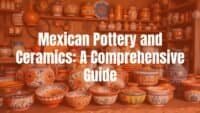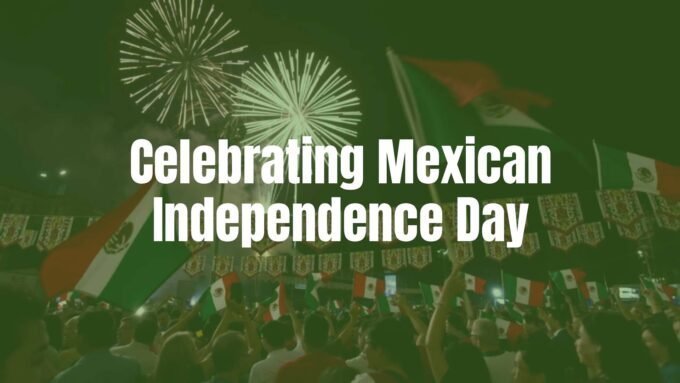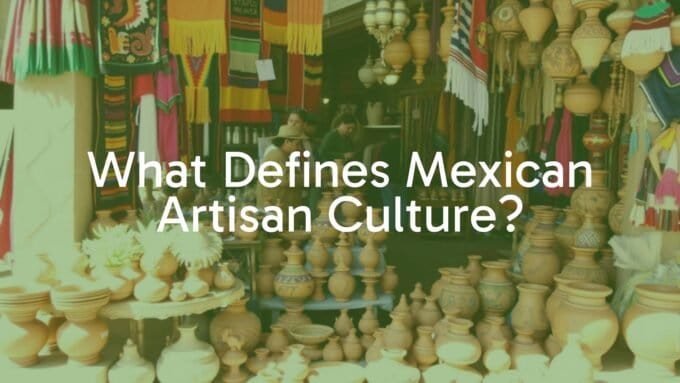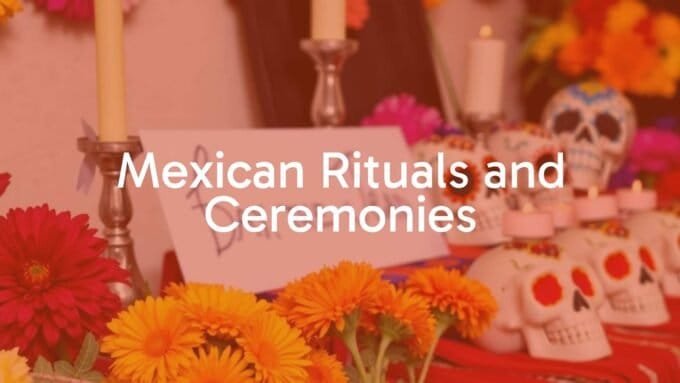What They Mean and Why They Matter
Traditional Mexican crafts, called “artesanía,” are much more than just decorations. They represent hundreds of years of culture and history. The word “artesanía” started being used in the 1900s to set apart these handmade pieces from factory-made products, showing their true roots and value. These crafts are Mexico’s way of showing its mixed heritage, combining native ways with European influence.
Mexican crafts touch every part of life, from household tools like clay pots and woven fabrics, to beautiful items made for celebrations, holidays, and religious moments. Skills are usually passed down within families and communities, often without schools, through careful practice and helping elders. Because of this, each item tells a story about daily life, dreams, beliefs, or respect.
Main Materials and Craft Techniques
Mexican crafts show creativity through the many materials and skills used. Makers use what’s around them, such as clay, wood, plant fibers, and metals, to shape their art. Clay has a long history in Mexico, even before the Spanish, who improved clay work by adding the potter’s wheel and new ways to glaze pots.
Textiles come from fibers like cotton, wool, and reeds, twisted and woven by hand. Craftspeople once used natural colors from plants and insects, though today artificial dyes are common. Metalwork, especially with silver, gold, and copper, was already advanced before the Spanish arrived, who later taught new metal techniques. Paper, leather, and even insects used for lacquer also play a role, giving Mexican crafts their own look and feel.

A Short History of Mexican Craftwork
Roots in Native Cultures
Mexican crafts go back to before the Spanish arrived. Early people like the Aztecs, Maya, Mixtecs, and Zapotecs had their own styles. These makers were important in their societies, creating clothes, feather art, pots, and jewelry. Early Spanish visitors, like Cortés, noticed the skill and beauty in Mexico’s markets. Bright colors-reds, greens, oranges, yellows, and turquoise-were common and used on temples, art, and objects for rituals.
Spanish Influence and Changes
When the Spanish came in the 1500s, they changed Mexican crafts. Many native styles were connected to old religions, so the Spanish tried to replace them, but they also taught new skills, such as saddlemaking and advanced pottery. The mix of both cultures led to new styles. In Michoacán, Vasco de Quiroga encouraged towns to focus on certain crafts, leading to strong local traditions that continue today.
Recent Changes and Modern Trends
After Mexico’s independence, old craft groups ended and many skills faded. In the early 1900s, after the Revolution, Mexican crafts became important again as symbols of national pride. Artists like Diego Rivera and Frida Kahlo used folk art in their work, making it popular. Though factories and imports compete with real handmade pieces, modern craftspeople are now recognized as artists, and groups like FONART help them. Younger makers experiment with fresh ideas, mixing old methods with new styles so Mexican crafts continue to grow and get noticed worldwide.

Main Kinds of Traditional Mexican Crafts
Ceramics and Pottery: Talavera and Black Clay
Ceramics are one of Mexico’s oldest crafts. Spanish tools and glazes, especially Majolica techniques, changed pottery forever. Talavera pottery from Puebla shows a mix of Chinese, Arab, Spanish, and native patterns, with bright, hand-painted tiles, bowls, and plates. These are still common in Puebla buildings. Some pottery keeps ancient looks, mostly for display.
Oaxaca’s shiny black clay was made famous by Rosa Real Mateo De Nieto in 1950. The unique baking and polishing give each piece a smooth, deep black look. “Tree of Life” sculptures also stand out, showing religious or decorative symbols. From everyday pots to glossy black clay, Mexican ceramics show lasting traditions.
Textiles and Weaving: Rebozos, Sarapes, and Otomi Stitching
Textiles have a long story in Mexico. Native people used back-strap looms to weave cotton and agave before the Spanish, who brought bigger treadle looms for larger items. Bright colors came from things like the cochineal bug, which gives red dye.
- Sarape: Warm, colorful garment from Tlaxcala or Coahuila.
- Rebozo: A classic shawl linked with Mexican women. Santa María del Río is famous for fine ones.
- Otomi embroidery: Brightly colored patterns, usually marking tribe, age, or marriage status. Projects like “Crafted in Mexico” share the hidden meanings in these fabrics.

Metalworking: Silver, Tin, and Copper
Mexican metalwork was already skilled before the Spanish, with copper, silver, and gold fashioned into thin sheets and jewelry. Spanish newcomers added new skills like filigree. Now, Taxco is Mexico’s silver center, while Michoacán shines for copper work. Each year, Santa Clara del Cobre has a copper festival. Tin, shaped and painted, is also used for shiny keepsakes, nicho boxes, and festival items.
Woodworking: Alebrijes, Instruments, and Furniture
Mexican woodwork covers everything from sturdy tables to lively carvings. In the past, noble homes had fancy hardwood furniture. After the conquest, Mexican woodworkers blended in European and Asian styles. Michoacán is still known for handmade furniture, painted or plain.
Alebrijes are fantasy animals made from different creatures’ parts. Created by Pedro Linares López in the 1930s, they started as cardboard figures, later being carved from wood, especially in Oaxaca. Wood also becomes musical instruments (like guitars and maracas) and ceremonial masks, like those from Hidalgo.

Paper Crafts: Papel Picado and Piñatas
Papel picado has roots in the Aztecs, who cut rough paper banners for ceremonies. Modern papel picado is made of brightly colored, cut tissue paper and hangs during events such as Day of the Dead and birthdays, often symbolizing the spiritual world’s closeness.
- Piñatas: Paper-mâché shapes filled with candy for breaking at parties. Though global now, they began as religious objects in central Mexico and have close ties to old Aztec practices.
Beadwork and Huichol Art
Huichol art, made by the Huichol people in western Mexico, uses colorful beads to create detailed images. Many designs are based on visions or stories. An “ojo de Dios” (God’s Eye), woven from yarn and sticks, is given for luck and protection. These crafts show both beauty and spiritual depth.
| Type of Craft | Region or Group | Main Materials | Famous Items |
|---|---|---|---|
| Ceramics | Puebla, Oaxaca | Clay | Talavera, Black Clay Pottery, Tree of Life |
| Textiles | Oaxaca, Chiapas, Tlaxcala | Cotton, Wool | Rebozos, Sarapes, Otomi embroidery |
| Metalwork | Taxco, Michoacán | Silver, Copper, Tin | Jewelry, Copper Pots, Tin Ornaments |
| Woodwork | Oaxaca, Michoacán | Wood | Alebrijes, Furniture, Masks, Instruments |
| Paper Art | Central Mexico | Papel (Paper) | Papel Picado, Piñatas |
| Beadwork | Huichol (Jalisco/Nayarit) | Beads, Yarn, Wood | Huichol Art, God’s Eyes |
Famous Regions and Craftspeople
- Oaxaca: Known for black clay pottery and traditional weaving, using time-honored natural dyes.
- Jalisco: Famous for crafting mariachi musical instruments and ceramics with local patterns.
- Guerrero: Recognized for wooden masks used in dances, and for Asian-influenced lacquered boxes, trays, and more.
- Michoacán: Specialists in copper items and straw-woven baskets and hats; also home to decorated furniture.
- Puebla: World-renowned for Talavera pottery-colorful tin-glazed ceramics decorating both houses and tableware.
- Chiapas/Yucatán: Mayan regions producing highly decorated textiles and polished amber jewelry, often filled with hidden meanings.
Crafts for Mexican Holidays and Celebrations
Day of the Dead: Sugar Skulls and Papel Picado
Day of the Dead, held on November 1st and 2nd, is one of Mexico’s biggest holidays. Crafts play a huge part. Sugar skulls or clay skeletons decorate altars to honor the dead, with bright colors and lively designs. Papel picado banners decorate homes and streets, and lots of flowers and traditional objects complete the scene.

Christmas: Piñatas and Tin Decorations
At Christmas, piñatas (often shaped like stars) are filled with treats and broken at parties, especially during “posadas.” Tin ornaments shaped like stars, angels, or nativity scenes hang in homes, adding shine and tradition to the season.
Cinco de Mayo and National Holidays
Cinco de Mayo on May 5 is a time for celebrating Mexican culture. Parties feature crafts in green, white, and red-the colors of the Mexican flag. Papel picado, miniature piñatas, paper flowers, and painted ceramics make events festive. Sombreros, maracas, and banners fill streets and houses during holidays noting Mexico’s national pride.
Symbolism in Mexican Crafts
Nature, Belief, and Daily Life
Mexican crafts carry deep meanings. Flowers, animals, earth, and stars often show up in designs, symbolizing parts of life or belief systems. Patterns aren’t just for looks-they share stories, cultural roots, and spiritual ideas going back generations. For example, animal shapes in fabric can point to local legends, while colors like red or turquoise can signal joy, earth, or protection.
Distinctive Patterns and Colors
Many Mexican patterns come from ancient geometric shapes, speaking of ancestry and local stories. Crafts are bright and colorful-reds, greens, blues-all show up everywhere, from fabric to painted pots. Spanish and Asian contacts brought new shapes and rich curves, seen in swirly “Baroque” designs. Whether on a Huichol beadwork or Otomi embroidery, these patterns tell history and identity through every stitch or line.
Why Are Traditional Mexican Crafts Important?
Protecting Heritage
Traditional crafts help keep Mexican history alive. Each handmade object, from a woven blanket to a silver bracelet, passes on skills, stories, and ways of living from parents to children, helping preserve culture that dates back centuries. Making these items isn’t just a job-it’s a way to honor the past and keep special knowledge alive for the future.
Economic Contribution
Crafts also help many communities survive. For a lot of families, especially in rural areas, selling artesanía is their main income. Tourists and collectors support these families by buying authentic items, keeping the local economy healthy and strong. Helping artisans keeps their communities working and makes sure ancient crafts aren’t lost.
National and Global Identity
Mexican crafts, from weavings to colorful ceramics, are symbols of Mexico’s identity and pride. Since the 1900s, Mexican artists have celebrated folk crafts as national symbols. They attract visitors and show off the color and variety of Mexican life. People buy them not just as souvenirs, but as a way to connect with Mexican culture.
Current Problems for Traditional Mexican Crafts
Mass Production and Fake Goods
Today, mass-produced items are making things hard for real artisans. Cheap copies from factories or other countries often use traditional designs but miss the real care and history. This keeps prices low, making it hard for real craftspeople to earn a living and for the craft’s value to be respected.
Disappearing Skills
Some special skills and old techniques are at risk of disappearing, as younger people often don’t see traditional crafts as a good way to make money. Many crafts need a lot of manual work and time, such as spinning thread or getting natural colors, which can seem less appealing today. To save these crafts, workshops and cultural programs are needed so new generations can learn.
Global Pressures and Changing Markets
Global trends give artisans new chances to sell their goods but also increase the pressure to work faster or change their art for modern tastes. This sometimes means focusing on what sells to tourists, possibly losing traditional character along the way. Artisans and groups now look for ways to keep craft traditions strong while still earning enough income.
How Are Traditions Passed On and Improved?
Family and Community Teaching
Most skill-sharing happens at home, with parents, grandparents, or older relatives showing children how to make things by hand. This way of learning builds close ties and keeps crafts part of the family tradition. Grandmothers especially play a big part, teaching not just how to make an item, but what it means.
Workshops, Fairs, and Programs
Government and private groups help keep crafts going by running workshops and fairs, showing crafts to local and global visitors, and helping artisans get noticed. Programs like FONART or “Crafted in Mexico” by Google, plus artisan fairs, help creators find markets and teach skills that might otherwise disappear.
Young Makers and New Ideas
Young artisans are finding ways to keep crafts exciting by blending old methods with modern touches, making things like tennis shoes or swimsuits with traditional embroidery. Collaborations with designers and digital sales help keep crafts alive and give them meaning for new buyers, ensuring they stay part of everyday life.
How to Help Mexican Artisans
Where to Find Real Crafts
The best way to support artisans is to buy crafts directly from them, especially at local markets or workshops in well-known regions like Oaxaca or Taxco. State-run shops (Casas de Artesanías) and certified galleries are good choices too, as they select genuine, well-made items. Always check to make sure you aren’t buying cheap imitations from tourist stalls.
Fair Shopping and Respect
Choosing crafts made through fair trade means paying makers a fair price. Many artisans still struggle with low earnings, so buying from co-ops or shops supporting artists helps them keep working and pass down traditions. Ask about how crafts are made and sold, and consider what goes into each piece.
Tourism and Responsible Visits
If you travel in Mexico, visit artisan workshops, learn directly from the makers, and understand the stories behind their crafts. Paying fairly and appreciating the work keeps the tradition strong and helps local economies. Taking time to talk to or watch artisans at work adds meaning and encourages respect for their skills.












Leave a comment